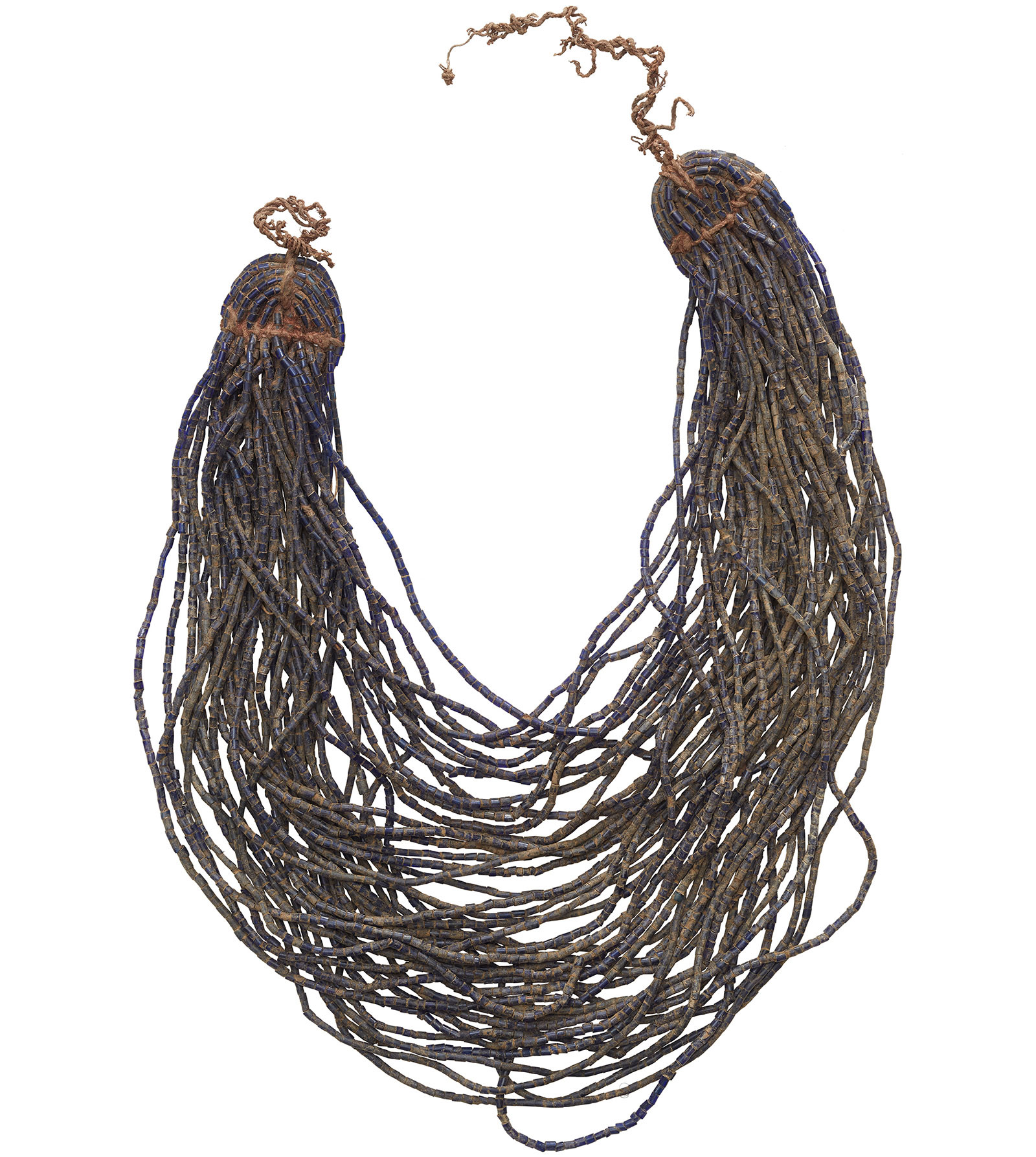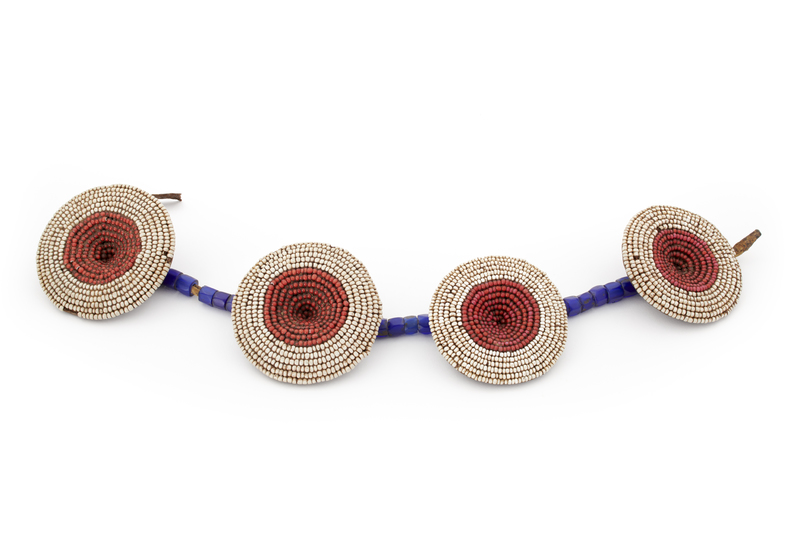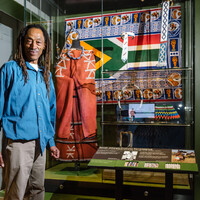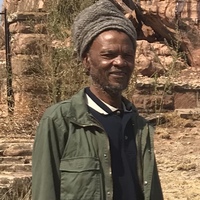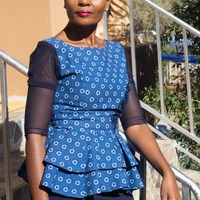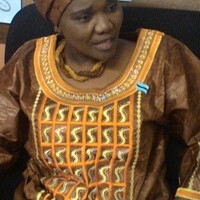Necklace; Charm; Leitlhô la tlou
Item
Title
Necklace; Charm; Leitlhô la tlou
Creator
Unrecorded
Subject
Body Adornment
Description
Physical Description: Necklace made from a length of leather strap threaded with large hexagonal dark blue beads and four large 'elephant eye' ornaments. These ornaments are made from discs of elephant hide decorated on the top surface with seven circles of red beads and six of white beads stitched onto the hide. The stitching is visible on the reverse. This woman's necklace was also worn as a charm by elephant hunters. [Royal Pavilion & Museums]
Contextual Description: necklace, with hide roundreds with decorated with reed and white coloured glass beads, red symbolises women ie. Not a child. Large blue glass beads. [Notes from Tshepo Skwambane and Neil Parsons initial visit to view objects, 2017]
Contextual Description: Leilho or Leitho? Dialect which can be confusing especially when written. TS comments
Contextual Description: necklace, with hide roundreds with decorated with reed and white coloured glass beads, red symbolises women ie. Not a child. Large blue glass beads . Notes from Tshepo Skwambane and Neil Parsons initial visit to view objects, 2017
Contextual Description: SL 52:24I don't know but it sounds like [Willoughby] asked questions from somebody with information.
SL 52:35
It'll make you think of an elephant's eye and our people always connecting…
SL 52:43
Beadwork that looks like an elephant eye if I want to go out and see elephant I must have elephant eyes
WT 54:04
in the kalanga culture, they have ... what would you call it in English I suppose a bucket
WT 54:16
They'll say it's so dark, it's like people are eating the eye of an Elephant.
WT 54:23
It is very deep meaning what a [???] wouldn't even want to know
WT 54:30
is that people are eating the eye of an Elephant that the kalanga and it's this eye of an Elephant. They're referring to something that is so far away
WT 54:48
I've had grown ups in their huts. Their traditional huts and they say, Oh, it's so dark it's like... because I only see people saying that ... and it is a very deep meaning and I don't want to be vulgar Oh, okay. Okay, so then the eye of an elephants, they will fit into something. It's dark and people are eating its eye
SL 56:33
Yeah, it might make a little sense in that elephant hunting was profitable. you kill an elephant you sell the ivory you get money to go and buy cattle which is some form of wealth amongst us. And the more elephants you have killed if you have like a [??] with that people will know who you are.
GK 56:57
It wasn't an easy task.
SL 57:00
People died, yes
NS 57:03
elephant meat is that can you eat elephant?
SL 57:06
Yeah, some people eat it
WT 57:09
but it's not like common meat
NS 57:11
No, no but obviously you've killed for the tusks, but then you have a huge...
WT 57:16
I think people up north, they would eat it
SL 57:19
Yeah.
WT 57:25
It's such a big thing, but I've heard people talk about skinning of the elephant that people would even be able to go inside.
SL 57:32
Inside the carcass
The above notes are from a transcription by Kathleen Lawther of a discussion between Gase Kediseng, JoAnn McGregor, Nicola Stylianou, Scobie Lekhuthile and Winani Thebele which took place at the Khama III Memorial Museum on the 5th of August 2019. To listen to the full recording please follow the link below.
SL 52:35
It'll make you think of an elephant's eye and our people always connecting…
SL 52:43
Beadwork that looks like an elephant eye if I want to go out and see elephant I must have elephant eyes
WT 54:04
in the kalanga culture, they have ... what would you call it in English I suppose a bucket
WT 54:16
They'll say it's so dark, it's like people are eating the eye of an Elephant.
WT 54:23
It is very deep meaning what a [???] wouldn't even want to know
WT 54:30
is that people are eating the eye of an Elephant that the kalanga and it's this eye of an Elephant. They're referring to something that is so far away
WT 54:48
I've had grown ups in their huts. Their traditional huts and they say, Oh, it's so dark it's like... because I only see people saying that ... and it is a very deep meaning and I don't want to be vulgar Oh, okay. Okay, so then the eye of an elephants, they will fit into something. It's dark and people are eating its eye
SL 56:33
Yeah, it might make a little sense in that elephant hunting was profitable. you kill an elephant you sell the ivory you get money to go and buy cattle which is some form of wealth amongst us. And the more elephants you have killed if you have like a [??] with that people will know who you are.
GK 56:57
It wasn't an easy task.
SL 57:00
People died, yes
NS 57:03
elephant meat is that can you eat elephant?
SL 57:06
Yeah, some people eat it
WT 57:09
but it's not like common meat
NS 57:11
No, no but obviously you've killed for the tusks, but then you have a huge...
WT 57:16
I think people up north, they would eat it
SL 57:19
Yeah.
WT 57:25
It's such a big thing, but I've heard people talk about skinning of the elephant that people would even be able to go inside.
SL 57:32
Inside the carcass
The above notes are from a transcription by Kathleen Lawther of a discussion between Gase Kediseng, JoAnn McGregor, Nicola Stylianou, Scobie Lekhuthile and Winani Thebele which took place at the Khama III Memorial Museum on the 5th of August 2019. To listen to the full recording please follow the link below.
Publisher
Making African Connections
Date
Pre 1899
Type
PhysicalObject
Format
Whole: 390 mm x 70 mm x 32 mm
leather; glass
Identifier
R4007/27
Source
Collected by Reverend William Charles Willoughby, a Christian missionary, in what was then the Bechuanaland Protectorate (1885-1966). It is now the Republic of Botswana, having gained independence from Britain in 1966.
From 1889-92 Willoughby was pastor at Union Street Church, Brighton (now The Font pub). From 1893 to 1898 he worked for the London Missionary Society in Bechuanaland. He assembled this collection of objects during this period. This was a period of social and technological changes and these objects represent traditional lifestyles and skills, rather than the contemporary lives of the people Willoughby met.
Willoughby's collection was loaned to Brighton Museum in 1899 when he returned to the UK. The loan was converted into a donation in 1936, and accessioned as acquisition R4007.
Some objects were re-numbered with the WA (World Art) numbering system in the 2000s. These numbers have been reverted to the original R4007/... numbers where possible for consistency in 2019.
This object was on display in the exhibition 'Missionary Collectors' in the James Green Gallery of World Art, from July 2004 to January 2005.
From 1889-92 Willoughby was pastor at Union Street Church, Brighton (now The Font pub). From 1893 to 1898 he worked for the London Missionary Society in Bechuanaland. He assembled this collection of objects during this period. This was a period of social and technological changes and these objects represent traditional lifestyles and skills, rather than the contemporary lives of the people Willoughby met.
Willoughby's collection was loaned to Brighton Museum in 1899 when he returned to the UK. The loan was converted into a donation in 1936, and accessioned as acquisition R4007.
Some objects were re-numbered with the WA (World Art) numbering system in the 2000s. These numbers have been reverted to the original R4007/... numbers where possible for consistency in 2019.
This object was on display in the exhibition 'Missionary Collectors' in the James Green Gallery of World Art, from July 2004 to January 2005.
William Charles Willoughby
Botswana, Southern Africa, Africa
1893-1898
Space/Place
Botswana, Southern Africa, Africa
Cultural Group: Tswana
Rights
Creative Commons Attribution-ShareAlike 4.0 International
Item sets
Linked resources
Filter by property
| Title | Alternate label | Class |
|---|---|---|
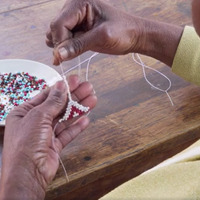 Beadwork Beadwork |

